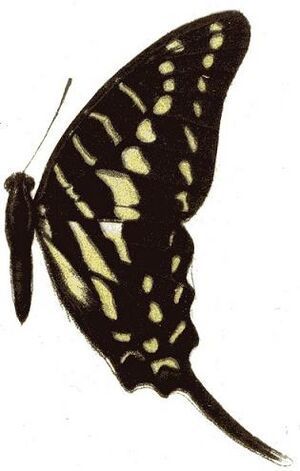Dancing swordtail facts for kids
Quick facts for kids Dancing swordtail |
|
|---|---|
 |
|
| Scientific classification | |
| Genus: |
Graphium (butterfly)
|
| Species: |
polistratus
|
| Synonyms | |
|
|
The Graphium polistratus, also known as the dancing swordtail, is a beautiful butterfly. It belongs to the Papilionidae family, which are often called swallowtail butterflies. You can find this butterfly in parts of Africa, including Nigeria, the Democratic Republic of the Congo, the coast of Kenya, Tanzania, northern Malawi, and Mozambique. It likes to live in warm, coastal forests.
What It Looks Like
The dancing swordtail has light green markings on its wings. On its front wings, the last three stripes inside the main cell are a bit curved. The back wings usually don't have a red spot on the top. Also, some of the larger spots on the back wings might be missing or very faint. The underside of the back wing also lacks a red spot near the cell's end.
There's a slightly different version of this butterfly called richelmanni. It has extra spots on its back wings that the main polistratus doesn't.
Life and Habits
Male dancing swordtail butterflies often gather in groups to "mud-puddle." This means they drink from damp soil or mud. They do this to get important minerals and nutrients. Both male and female butterflies also visit flowers to drink nectar. These butterflies are likely active all year long.
The young butterflies, called larvae (or caterpillars), eat leaves from certain plants. Their favorite foods are the Annona senegalensis plant and different types of Uvaria plants.
Butterfly Family Tree
Scientists group living things into categories. This helps them understand how different species are related. The Graphium polistratus is part of a group of butterflies called the antheus-clade. This group includes other similar butterflies like Graphium antheus and Graphium colonna. They all share some common features.
See also
- Shimba Hills National Reserve

